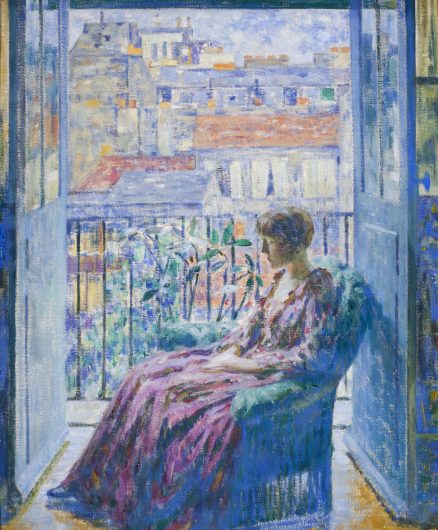- Categories
- Figural works
- Immigrant artists
- Women
- Zoom in on Artwork
- Print Page
- Email Page to Friend
A seated woman is squarely framed by a pair of French windows open to a cityscape in Louis Ritman’s Paris View. The foreshortened casement windows, balcony railing, and distant houses form a rigid rectilinear structure relieved by the curves of the model’s body and her wicker armchair. With her idle hands, face in profile, and downcast or closed eyes, the woman is a static presence subordinated to the composition’s architectonic structure. Ritman’s image is suffused with pastel tints dominated by blues and further unified by the distinctive allover patterning of the surface in a tapestrylike arrangement of dryly brushed discrete patches of paint; in places, the white ground is clearly visible.
The original title of this work is unknown, as is the date it was executed, but Ritman almost certainly painted it during World War I. Except for the autumn and winter of 1914–1915, the artist spent the war years working in Paris, with summers in the Normandy village of Giverny, an international center for impressionist painting. Like Lawton Parker and his other close associates there, Ritman often placed the figure against an open window in his indoor images. In his Giverny paintings, this device allowed a glimpse of a richly colored sunlit garden. Here, however, the backdrop to the figure is apparently the vista of hilly Montparnasse, a neighborhood favored by artists, where Ritman had his studio-residence. With her graceful form and fashionable cropped hairstyle, the seated woman in Paris View appears to be the Frenchwoman now known only as Mimi; Ritman’s favorite model, she also posed for him in Giverny.
During his first years in Giverny, between 1911 and 1914, Ritman followed the example of other American painters working there in focusing on the figure and using a decorative impressionist style to convey the effects of dappled light on brightly colored surfaces. Around 1915, however, his approach shifted as he became increasingly interested in more purely formal concerns of composition and paint application. In this work, lines, planes, and surface pattern take precedence over rich color and the beauty of the female form. The detachment between viewer and model—whose expression, if any, is closed—illustrates the artist’s exploration beyond the impressionism with which he had recently won a place in the Chicago and national art scenes.
Wendy Greenhouse, PhD
